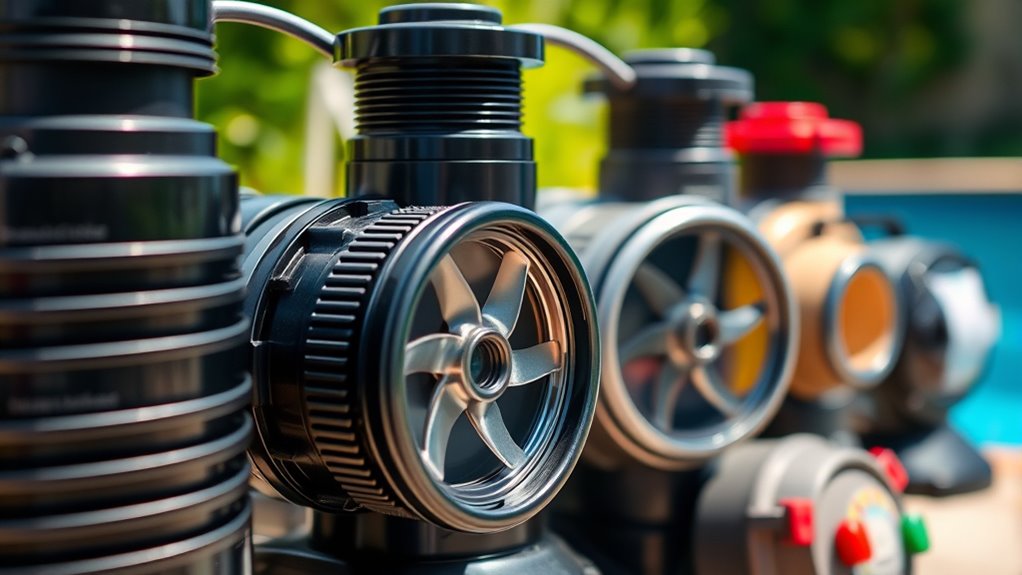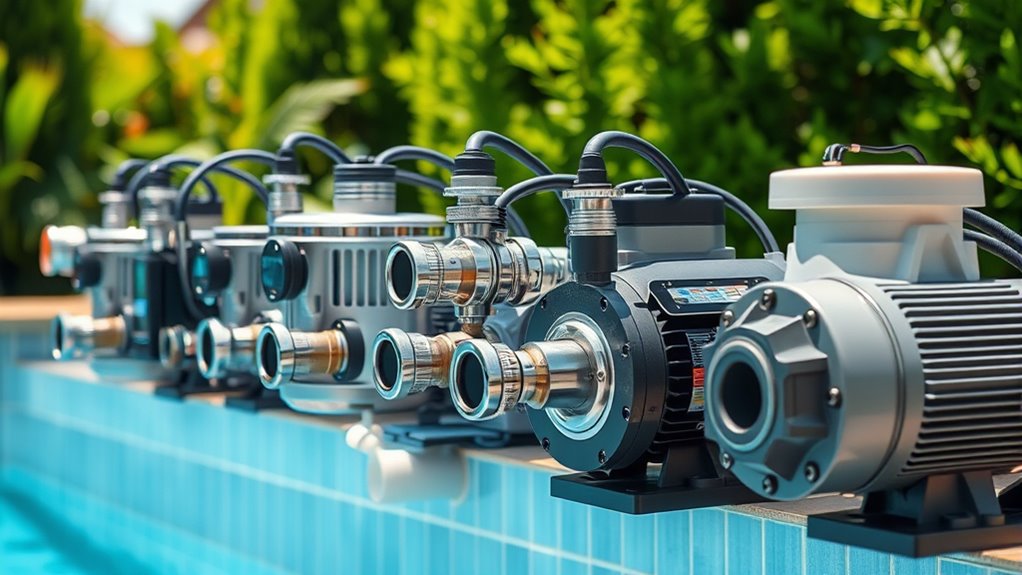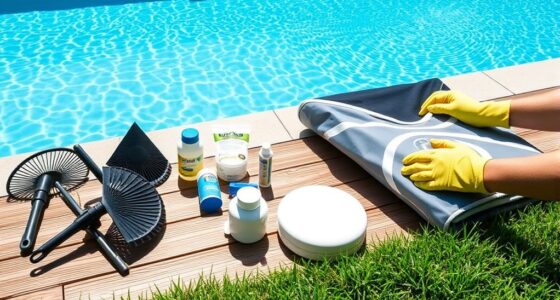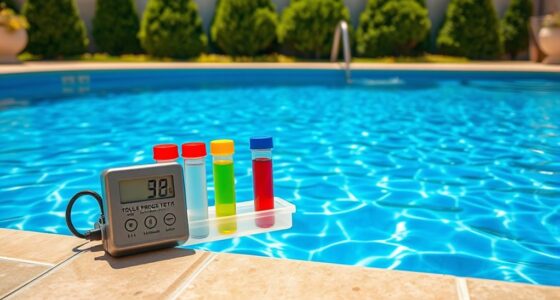Understanding pool pump types and sizing helps you choose the right pump for efficient water circulation and energy savings. You’ll want to think about whether to pick single or variable-speed models, which impact noise and cost, and guarantee the pump’s flow rate matches your pool’s size for ideal performance. Proper sizing prevents unnecessary energy use and noise. Keep exploring to learn how to select the best pump for your pool’s needs and keep your water clear.
Key Takeaways
- Identify different pool pump types, such as single-speed, dual-speed, and variable-speed models, to match your needs.
- Determine the pool’s volume and turnover rate to select the appropriate pump size for efficient circulation.
- Consider energy efficiency features like variable-speed motors to reduce operating costs and extend pump lifespan.
- Match pump flow rate to plumbing size and pool volume to prevent under or over-circulation.
- Assess noise levels and additional features to choose a pump that balances performance, quiet operation, and budget.

Choosing the right pool pump is essential for efficient circulation and maintaining clean water. The pump you select impacts not only how well your pool stays clear but also how much energy you consume and how loud it gets during operation. When evaluating different pump options, you’ll want to pay close attention to their energy efficiency and noise levels, as these factors can considerably influence your ongoing costs and comfort.
Energy efficiency is a key consideration because your pool pump runs for many hours each day. A more efficient pump uses less electricity to move the same amount of water, which translates into lower utility bills and a smaller carbon footprint. Look for models with high efficiency ratings or those labeled as energy-efficient pumps, often equipped with advanced motor technology. Variable-speed pumps are especially popular because they can adjust their speed based on your pool’s needs, using less power when full-speed operation isn’t necessary. This flexibility not only saves you money but also reduces wear and tear on the motor, extending the lifespan of your pump.
Energy-efficient pumps with variable-speed motors save money and extend pump lifespan.
Noise levels are another important aspect that often gets overlooked. A louder pump can disrupt your peace and quiet, especially if your pool is close to your house or outdoor living spaces. Modern pumps are designed with noise reduction features, such as insulated motors and sound-dampening enclosures, which help keep operational noise to a minimum. When shopping, check the decibel ratings provided by manufacturers; a pump with a lower decibel rating will be much more tolerable during those long hours of operation. If you use your pool frequently or have a patio nearby, choosing a quieter model makes your swimming and lounging experience more enjoyable.
In addition to energy efficiency and noise levels, consider the pump’s size and flow rate. A pump that’s too powerful can waste energy and create unnecessary noise, while one that’s too small may struggle to circulate water properly, leading to murky water and algae growth. Proper sizing involves matching the pump’s flow rate to your pool’s volume and plumbing setup. Typically, a pool’s turnover rate—how quickly the entire volume of water is filtered—guides your decision. Ensuring the pump is appropriately sized helps you optimize both performance and efficiency. Additionally, understanding the hydraulics involved can help you select a pump that provides effective circulation without excessive strain on your system.
Ultimately, selecting the right pool pump means balancing your priorities: choosing one that offers high energy efficiency to save on costs, low noise levels for comfort, and proper sizing for effective circulation. Doing so ensures your pool stays clean, your energy bills stay manageable, and your outdoor space remains peaceful and enjoyable.
Frequently Asked Questions
How Often Should I Replace My Pool Pump?
You should replace your pool pump every 8 to 10 years, depending on usage and maintenance. Regular pump maintenance helps extend its life, but a replacement schedule is vital to keep your pool running efficiently. Watch for signs like loud operation, leaks, or decreased flow, which indicate it’s time for a new pump. Staying proactive ensures peak performance and avoids costly repairs down the line.
Can I Upgrade My Pool Pump Without Rewiring?
Yes, you can upgrade your pool pump without rewiring if the new pump has a compatible plug and voltage. During pool maintenance, check your current wiring to verify it’s suitable for the new pump’s requirements. Upgrading can extend your pump’s lifespan and improve efficiency, but ensure the electrical setup matches. If unsure, consult a professional to avoid safety issues and ensure proper installation.
What’s the Impact of Pump Noise on My Backyard?
Pool noise can considerably impact your backyard, causing disturbance during relaxation or gatherings. If your pump is loud, it might disrupt your outdoor enjoyment and bother neighbors. You can reduce this impact by choosing a quieter pump, adding soundproofing measures, or relocating it further from lounging areas. Managing pool noise helps guarantee your backyard remains a peaceful retreat, free from unnecessary disturbance.
Are Energy-Efficient Pumps Worth the Investment?
Yes, energy-efficient pumps are worth the investment. They help you save on energy costs over time, making your pool maintenance more affordable. Although they might cost a bit more upfront, you’ll notice significant energy savings and lower long-term costs. Plus, they often operate more quietly and reduce wear and tear on your system, ensuring your pool stays clean without draining your budget.
How Does Pool Usage Affect Pump Size Requirements?
Your pool usage directly impacts pump size requirements because higher water turnover demands a more powerful pump to maintain filtration efficiency. If you use your pool frequently or have a large volume, choose a pump that can handle increased flow rates to keep the water clear. Conversely, less usage means a smaller pump may suffice, ensuring consistent filtration efficiency without unnecessary energy consumption.
Conclusion
So, next time you pick a pool pump, remember: size and type really do matter. It’s almost funny how choosing the wrong one can turn your relaxing oasis into a noisy nightmare or a algae-filled swamp. But don’t worry—just follow the basics, and you’ll avoid the ironic mistake of spending more on energy and repairs than your actual pool. After all, who knew that a pump could make or break your perfect backyard retreat?









